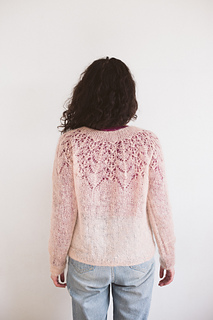patterns >  Camila Larsen's Ravelry Store
Camila Larsen's Ravelry Store
> Diafanía













Diafanía
ENGLISH (en español más abajo)
Chest measurements: 35.5 (39, 43.5, 48, 51.5) (55, 58.5, 62, 66.5)” /90 (99, 110, 121, 130) (139, 148, 157,168) cm.
These are the final garment measurements taken after blocking. The sweater is intended to be worn with a 8-12% positive ease around the upper chest.
Yarn: Qing Fibre’s Kid Mohair Silk 70% Ultra-fine kid mohair, 30% silk; lace weight; 420m per each 50g skein)
Gauge: 17 stitches x 20 rounds = 4 in / 10 cm using stockinette stitch in the round with US7 / 4.5 mm needles or the size needed to obtain gauge, measured after blocking.
Design overview: Diafanía is a top-down circular yoke sweater knit in the round. It begins at the neckline with a 1x1 ribbing and some short-rows shaping. A lace stitch is used in the yoke, you might choose to follow either the written instructions or the diagram when working this section. Once the body is separated from the sleeves you will work in stockinette stitch until achieving desired length and finish with a ribbed edge. The sleeves also use stockinette stitch and there are some decreases before the cuff to get a slightly ballon shape.
The sample was knit with a single lace mohair strand and a big needle size to obtain that lacy and diaphanous look, but feel free to experiment with more strands or even a different yarn weight. As long as you reach the same gauge tension it will be OK.
YARDAGE / METRAJE
Shorter version/versión corta: 590-650 (645-710, 665-730, 785-860, 940-1030)
(1030-1130, 1110-1220, 1190-1310, 1280-1405) yds / 540-595 (590-650, 610-670,720-790, 860-945) (940-1035, 1015-1115,
1090-1200, 1170-1285) m.
Longer version/versión larga: 825-905 (905-1000, 965-1065, 1130-1245, 1310-
1445) (1435-1580, 1560-1715, 1680-1850, 1810-1990) yds / 755-830 (830-915, 885-975, 1035-1140, 1200-1320) (1315-1445,
1425-1570, 1535-1690, 1655-1820) m.
ESPAÑOL
Medidas de la prenda: 90 (99, 110, 121, 130) (139, 148, 157,168) cm. Estas medidas corresponden a la circunferencia del pecho de la prenda tejida, después de bloquear.
Materiales: Kid mohair silk de Qing Fibre 70% Ultra-fine kid mohair, 30% silk; grosor lace; 420m por cada madeja de 50g)
Muestra de tensión: 17 puntos de ancho x 20 Vueltas de alto = 10 cm en punto jersey tejido tubularmente con palillos de 4.5 mm o el grosor necesario para obtener la muestra, medido después de bloquear.
Construcción: Diafanía es un sweater de pechera circular que se teje tubularmente desde arriba hacia abajo. Comienza por el cuello con punto elástico simple, donde además incorpora una sección de vueltas cortas. La pechera continúa con una patrón de encaje que puedes trabajar ya sea siguiendo las instrucciones escritas o los gráficos. Cuando alcanza la altura deseada es momento de separar el cuerpo de las mangas. El cuerpo, tejido en punto jersey, tiene dos largos posibles que puedes elegir según la tabla de medidas. La manga también se trabaja con
punto jersey y es ligeramente aglobada, un efecto obtenido gracias a disminuciones ubicadas antes del puño.
La muestra fue tejida con una hebra de mohair de grosor lace y un grosor de palillos más grande que lo usual para alcanzar esa apariencia diáfana del encaje. Sin embargo, tienes la libertad de experimentar ya sea usando más hebras, un grosor distinto u otro tipo de fibra. Mientras alcances la misma muestra de tensión está todo bien.
795 projects
stashed
733 times
- First published: July 2021
- Page created: July 17, 2021
- Last updated: May 8, 2025 …
- visits in the last 24 hours
- visitors right now




